Schahram Dustdar
Multi-Dimensional Autoscaling of Stream Processing Services on Edge Devices
Oct 08, 2025
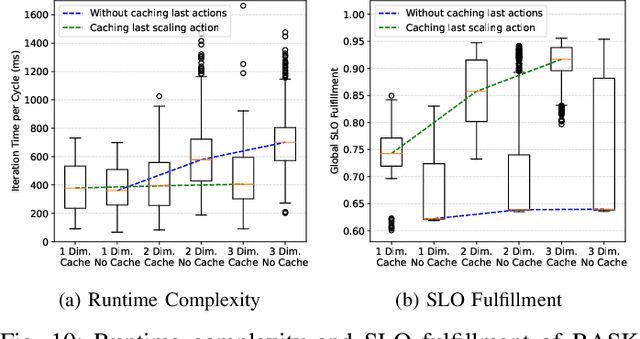
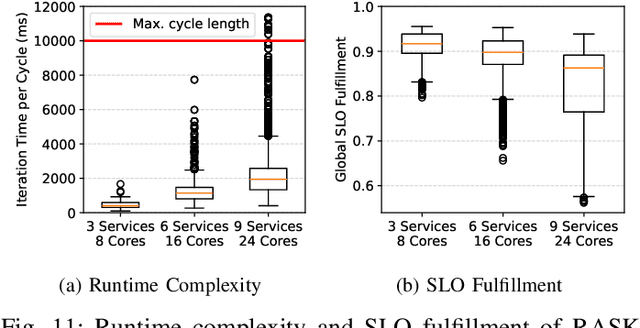

Abstract:Edge devices have limited resources, which inevitably leads to situations where stream processing services cannot satisfy their needs. While existing autoscaling mechanisms focus entirely on resource scaling, Edge devices require alternative ways to sustain the Service Level Objectives (SLOs) of competing services. To address these issues, we introduce a Multi-dimensional Autoscaling Platform (MUDAP) that supports fine-grained vertical scaling across both service- and resource-level dimensions. MUDAP supports service-specific scaling tailored to available parameters, e.g., scale data quality or model size for a particular service. To optimize the execution across services, we present a scaling agent based on Regression Analysis of Structural Knowledge (RASK). The RASK agent efficiently explores the solution space and learns a continuous regression model of the processing environment for inferring optimal scaling actions. We compared our approach with two autoscalers, the Kubernetes VPA and a reinforcement learning agent, for scaling up to 9 services on a single Edge device. Our results showed that RASK can infer an accurate regression model in merely 20 iterations (i.e., observe 200s of processing). By increasingly adding elasticity dimensions, RASK sustained the highest request load with 28% less SLO violations, compared to baselines.
Edge Intelligence with Spiking Neural Networks
Jul 18, 2025Abstract:The convergence of artificial intelligence and edge computing has spurred growing interest in enabling intelligent services directly on resource-constrained devices. While traditional deep learning models require significant computational resources and centralized data management, the resulting latency, bandwidth consumption, and privacy concerns have exposed critical limitations in cloud-centric paradigms. Brain-inspired computing, particularly Spiking Neural Networks (SNNs), offers a promising alternative by emulating biological neuronal dynamics to achieve low-power, event-driven computation. This survey provides a comprehensive overview of Edge Intelligence based on SNNs (EdgeSNNs), examining their potential to address the challenges of on-device learning, inference, and security in edge scenarios. We present a systematic taxonomy of EdgeSNN foundations, encompassing neuron models, learning algorithms, and supporting hardware platforms. Three representative practical considerations of EdgeSNN are discussed in depth: on-device inference using lightweight SNN models, resource-aware training and updating under non-stationary data conditions, and secure and privacy-preserving issues. Furthermore, we highlight the limitations of evaluating EdgeSNNs on conventional hardware and introduce a dual-track benchmarking strategy to support fair comparisons and hardware-aware optimization. Through this study, we aim to bridge the gap between brain-inspired learning and practical edge deployment, offering insights into current advancements, open challenges, and future research directions. To the best of our knowledge, this is the first dedicated and comprehensive survey on EdgeSNNs, providing an essential reference for researchers and practitioners working at the intersection of neuromorphic computing and edge intelligence.
Multi-dimensional Autoscaling of Processing Services: A Comparison of Agent-based Methods
Jun 12, 2025Abstract:Edge computing breaks with traditional autoscaling due to strict resource constraints, thus, motivating more flexible scaling behaviors using multiple elasticity dimensions. This work introduces an agent-based autoscaling framework that dynamically adjusts both hardware resources and internal service configurations to maximize requirements fulfillment in constrained environments. We compare four types of scaling agents: Active Inference, Deep Q Network, Analysis of Structural Knowledge, and Deep Active Inference, using two real-world processing services running in parallel: YOLOv8 for visual recognition and OpenCV for QR code detection. Results show all agents achieve acceptable SLO performance with varying convergence patterns. While the Deep Q Network benefits from pre-training, the structural analysis converges quickly, and the deep active inference agent combines theoretical foundations with practical scalability advantages. Our findings provide evidence for the viability of multi-dimensional agent-based autoscaling for edge environments and encourage future work in this research direction.
A Trustworthy Multi-LLM Network: Challenges,Solutions, and A Use Case
May 06, 2025Abstract:Large Language Models (LLMs) demonstrate strong potential across a variety of tasks in communications and networking due to their advanced reasoning capabilities. However, because different LLMs have different model structures and are trained using distinct corpora and methods, they may offer varying optimization strategies for the same network issues. Moreover, the limitations of an individual LLM's training data, aggravated by the potential maliciousness of its hosting device, can result in responses with low confidence or even bias. To address these challenges, we propose a blockchain-enabled collaborative framework that connects multiple LLMs into a Trustworthy Multi-LLM Network (MultiLLMN). This architecture enables the cooperative evaluation and selection of the most reliable and high-quality responses to complex network optimization problems. Specifically, we begin by reviewing related work and highlighting the limitations of existing LLMs in collaboration and trust, emphasizing the need for trustworthiness in LLM-based systems. We then introduce the workflow and design of the proposed Trustworthy MultiLLMN framework. Given the severity of False Base Station (FBS) attacks in B5G and 6G communication systems and the difficulty of addressing such threats through traditional modeling techniques, we present FBS defense as a case study to empirically validate the effectiveness of our approach. Finally, we outline promising future research directions in this emerging area.
UserCentrix: An Agentic Memory-augmented AI Framework for Smart Spaces
May 01, 2025Abstract:Agentic AI, with its autonomous and proactive decision-making, has transformed smart environments. By integrating Generative AI (GenAI) and multi-agent systems, modern AI frameworks can dynamically adapt to user preferences, optimize data management, and improve resource allocation. This paper introduces UserCentrix, an agentic memory-augmented AI framework designed to enhance smart spaces through dynamic, context-aware decision-making. This framework integrates personalized Large Language Model (LLM) agents that leverage user preferences and LLM memory management to deliver proactive and adaptive assistance. Furthermore, it incorporates a hybrid hierarchical control system, balancing centralized and distributed processing to optimize real-time responsiveness while maintaining global situational awareness. UserCentrix achieves resource-efficient AI interactions by embedding memory-augmented reasoning, cooperative agent negotiation, and adaptive orchestration strategies. Our key contributions include (i) a self-organizing framework with proactive scaling based on task urgency, (ii) a Value of Information (VoI)-driven decision-making process, (iii) a meta-reasoning personal LLM agent, and (iv) an intelligent multi-agent coordination system for seamless environment adaptation. Experimental results across various models confirm the effectiveness of our approach in enhancing response accuracy, system efficiency, and computational resource management in real-world application.
Leveraging Neural Graph Compilers in Machine Learning Research for Edge-Cloud Systems
Apr 28, 2025Abstract:This work presents a comprehensive evaluation of neural network graph compilers across heterogeneous hardware platforms, addressing the critical gap between theoretical optimization techniques and practical deployment scenarios. We demonstrate how vendor-specific optimizations can invalidate relative performance comparisons between architectural archetypes, with performance advantages sometimes completely reversing after compilation. Our systematic analysis reveals that graph compilers exhibit performance patterns highly dependent on both neural architecture and batch sizes. Through fine-grained block-level experimentation, we establish that vendor-specific compilers can leverage repeated patterns in simple architectures, yielding disproportionate throughput gains as model depth increases. We introduce novel metrics to quantify a compiler's ability to mitigate performance friction as batch size increases. Our methodology bridges the gap between academic research and practical deployment by incorporating compiler effects throughout the research process, providing actionable insights for practitioners navigating complex optimization landscapes across heterogeneous hardware environments.
Benchmarking Dynamic SLO Compliance in Distributed Computing Continuum Systems
Mar 05, 2025Abstract:Ensuring Service Level Objectives (SLOs) in large-scale architectures, such as Distributed Computing Continuum Systems (DCCS), is challenging due to their heterogeneous nature and varying service requirements across different devices and applications. Additionally, unpredictable workloads and resource limitations lead to fluctuating performance and violated SLOs. To improve SLO compliance in DCCS, one possibility is to apply machine learning; however, the design choices are often left to the developer. To that extent, we provide a benchmark of Active Inference -- an emerging method from neuroscience -- against three established reinforcement learning algorithms (Deep Q-Network, Advantage Actor-Critic, and Proximal Policy Optimization). We consider a realistic DCCS use case: an edge device running a video conferencing application alongside a WebSocket server streaming videos. Using one of the respective algorithms, we continuously monitor key performance metrics, such as latency and bandwidth usage, to dynamically adjust parameters -- including the number of streams, frame rate, and resolution -- to optimize service quality and user experience. To test algorithms' adaptability to constant system changes, we simulate dynamically changing SLOs and both instant and gradual data-shift scenarios, such as network bandwidth limitations and fluctuating device thermal states. Although the evaluated algorithms all showed advantages and limitations, our findings demonstrate that Active Inference is a promising approach for ensuring SLO compliance in DCCS, offering lower memory usage, stable CPU utilization, and fast convergence.
Adversarial Robustness of Bottleneck Injected Deep Neural Networks for Task-Oriented Communication
Dec 13, 2024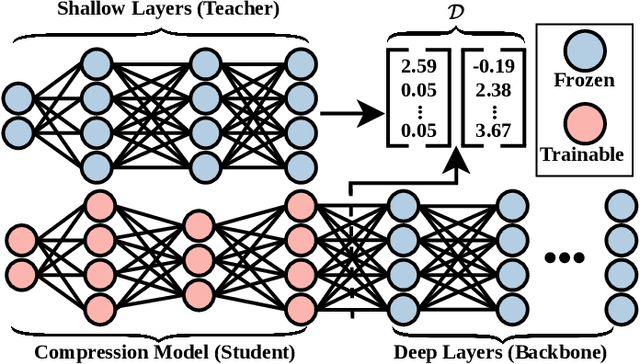
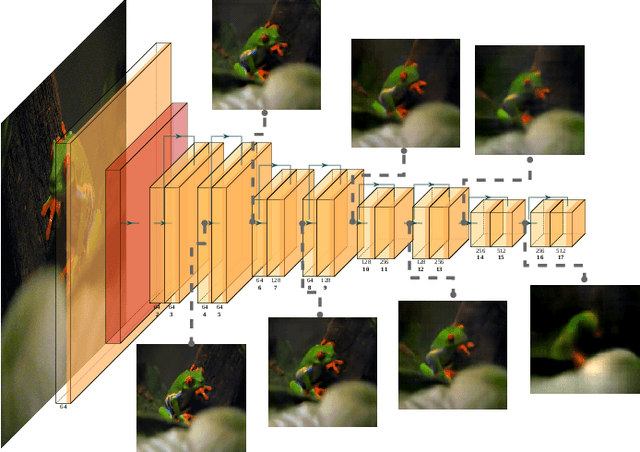
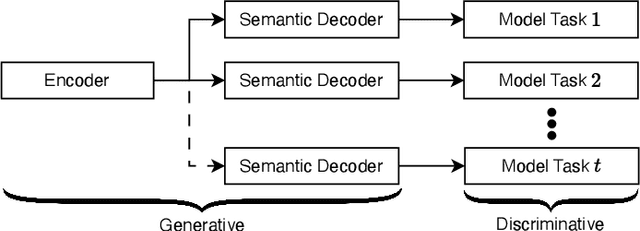
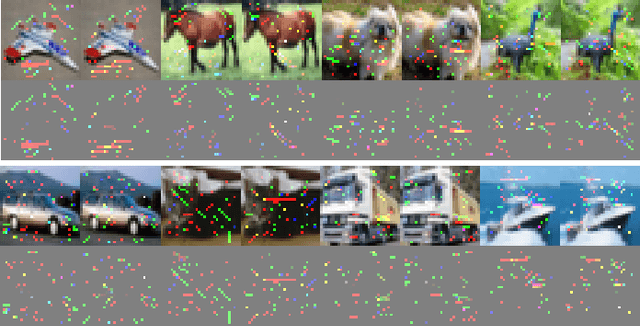
Abstract:This paper investigates the adversarial robustness of Deep Neural Networks (DNNs) using Information Bottleneck (IB) objectives for task-oriented communication systems. We empirically demonstrate that while IB-based approaches provide baseline resilience against attacks targeting downstream tasks, the reliance on generative models for task-oriented communication introduces new vulnerabilities. Through extensive experiments on several datasets, we analyze how bottleneck depth and task complexity influence adversarial robustness. Our key findings show that Shallow Variational Bottleneck Injection (SVBI) provides less adversarial robustness compared to Deep Variational Information Bottleneck (DVIB) approaches, with the gap widening for more complex tasks. Additionally, we reveal that IB-based objectives exhibit stronger robustness against attacks focusing on salient pixels with high intensity compared to those perturbing many pixels with lower intensity. Lastly, we demonstrate that task-oriented communication systems that rely on generative models to extract and recover salient information have an increased attack surface. The results highlight important security considerations for next-generation communication systems that leverage neural networks for goal-oriented compression.
Reactive Orchestration for Hierarchical Federated Learning Under a Communication Cost Budget
Dec 04, 2024Abstract:Deploying a Hierarchical Federated Learning (HFL) pipeline across the computing continuum (CC) requires careful organization of participants into a hierarchical structure with intermediate aggregation nodes between FL clients and the global FL server. This is challenging to achieve due to (i) cost constraints, (ii) varying data distributions, and (iii) the volatile operating environment of the CC. In response to these challenges, we present a framework for the adaptive orchestration of HFL pipelines, designed to be reactive to client churn and infrastructure-level events, while balancing communication cost and ML model accuracy. Our mechanisms identify and react to events that cause HFL reconfiguration actions at runtime, building on multi-level monitoring information (model accuracy, resource availability, resource cost). Moreover, our framework introduces a generic methodology for estimating reconfiguration costs to continuously re-evaluate the quality of adaptation actions, while being extensible to optimize for various HFL performance criteria. By extending the Kubernetes ecosystem, our framework demonstrates the ability to react promptly and effectively to changes in the operating environment, making the best of the available communication cost budget and effectively balancing costs and ML performance at runtime.
Adaptive Active Inference Agents for Heterogeneous and Lifelong Federated Learning
Oct 09, 2024Abstract:Handling heterogeneity and unpredictability are two core problems in pervasive computing. The challenge is to seamlessly integrate devices with varying computational resources in a dynamic environment to form a cohesive system that can fulfill the needs of all participants. Existing work on systems that adapt to changing requirements typically focuses on optimizing individual variables or low-level Service Level Objectives (SLOs), such as constraining the usage of specific resources. While low-level control mechanisms permit fine-grained control over a system, they introduce considerable complexity, particularly in dynamic environments. To this end, we propose drawing from Active Inference (AIF), a neuroscientific framework for designing adaptive agents. Specifically, we introduce a conceptual agent for heterogeneous pervasive systems that permits setting global systems constraints as high-level SLOs. Instead of manually setting low-level SLOs, the system finds an equilibrium that can adapt to environmental changes. We demonstrate the viability of AIF agents with an extensive experiment design, using heterogeneous and lifelong federated learning as an application scenario. We conduct our experiments on a physical testbed of devices with different resource types and vendor specifications. The results provide convincing evidence that an AIF agent can adapt a system to environmental changes. In particular, the AIF agent can balance competing SLOs in resource heterogeneous environments to ensure up to 98% fulfillment rate.
 Add to Chrome
Add to Chrome Add to Firefox
Add to Firefox Add to Edge
Add to Edge